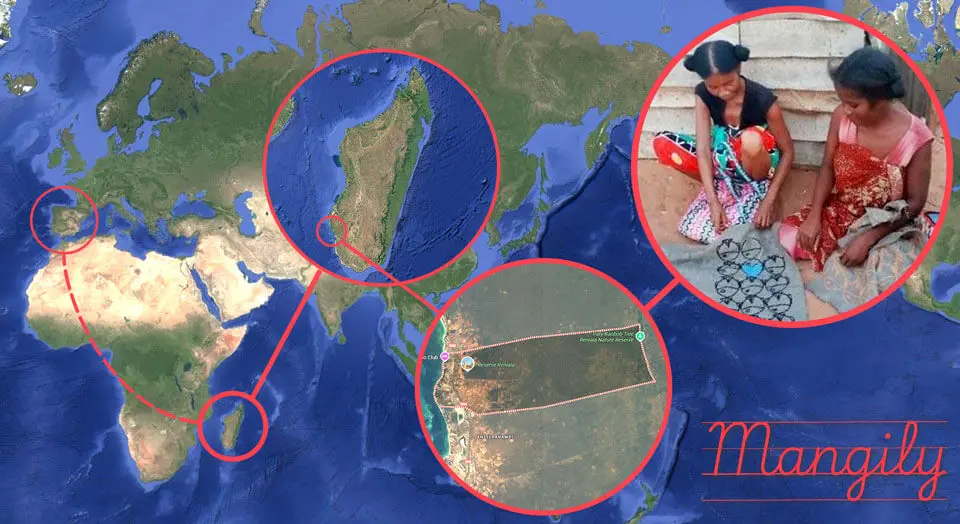About us

In the beginning
El hilo y el baobab arises from a personal concern. During the summer of 2018, I spent several weeks in a small coastal village in the south of Madagascar called Mangily. There I had the opportunity to live alongside the local population and formed friendships with several women and a fisherman with whom I maintained contact after my stay.
During those weeks, I became aware of some problems associated with poverty that afflict a large part of the country's population: child malnutrition, low school enrolment, child labour, and the risk of sexual exploitation of adolescent girls, especially in the presence of a certain type of tourist.
In the summer of 2019, I was able to go back with my cousin Manu Cid, who is a filmmaker, with the intention of creating a short documentary that would allow this issue to be visualised. The documentary, featuring the fisherman, was titled Vezo (in Malagasy means "Those who deal with the sea") and has received recognition at various film festivals.
In the year 2020, as a result of the pandemic, the island of Madagascar was completely closed to tourism. The women told me that they were suffering from a lack of food. After two months of sending financial support and seeing that this situation would be unsustainable in the long term, this project emerged with the idea of generating the resources they needed from their own efforts. The women and the fisherman organised themselves, and thus began their journey.
At the same time, with the support of several people, in September 2018 the children of these families gained access to the school. Since then, more children have joined the schooling project..
We have recently established ourselves as a non-profit Association, including both activities in our statutes: support for education and the project for job creation through the making of embroidered products. All of this constitutes the Association. El hilo y el baobab.
Location
The project takes place in Madagascar, in a small coastal village called Mangily, located in the southwest of the island and 30 km from Toliara, the capital of the region.
Madagascar is the largest island in Africa. It is located to the southeast of the African continent, off the coast of Mozambique, in the Indian Ocean. It ranks as one of the poorest countries in the world, where more than 80% of the population lives below the poverty line. On the other hand, Madagascar is rich in natural resources, has mineral deposits, oil, and a unique biodiversity that generates interest from biologists, researchers, and tourists from all over the world.
Mangily is a tourist town due to the enormous appeal of its beaches. The contrast between the hotel area, located on the beachfront, and the interior of the town highlights the inequalities that the local population faces on a daily basis.
While tourism brings clear benefits (the hotel industry promotes job creation among locals, provides an immediate outlet for the efforts of local fishermen and farmers, etc.), it also entails serious problems that have a negative impact on the local population. Perhaps the most serious is a previously mentioned issue: the sexual exploitation to which adolescent girls from extremely poor families are exposed, whose parents see this source of income as a solution to their significant economic needs. Another problem relates to the myth of African inferiority, according to which the gaze of the white man and his prejudices produce a negative effect on the self-esteem and collective psychology of the population as a whole..

Our objectives
Main objective
Promote the economic autonomy of the individuals participating in the project.
Specific objectives
- Promote employability among women in Mangily.
- Support the discovery of certain abilities in individuals who, due to their social circumstances, have not learned any trade beyond domestic tasks..
- Reinforce the self-esteem, sense of usefulness, and dignity of the participants in the project.
- Promote the schooling of minors to prevent child labour.
- To promote economic and educational conditions in families that may eventually protect their daughters from having to resort to prostitution.
- Foster the conditions for good nutrition that allow for the prevention of malnutrition.
A tale
An African legend tells that, a long time ago, baobabs were robust and precious trees that bore the most beautiful flowers. The gods, impressed by their beauty, granted these trees the gift of immortality. Then, proud of their new condition, they began to grow and grow without limits, aiming to reach the abode of the gods. Everything beneath them was cast into shadow, and while the baobabs enjoyed their grandeur, the rest of the plants and animals in the African lands suffered from a lack of light and space. Then the gods, enraged by the arrogance of the baobabs, decided to punish these trees by turning them upside down. They buried their flowers underground and placed their dry, grey roots pointing towards the sky. And this is how Africans explain the peculiar shape of these trees.